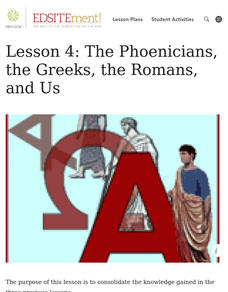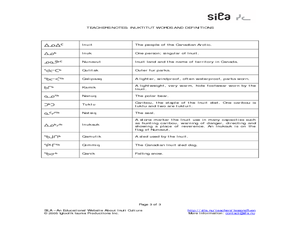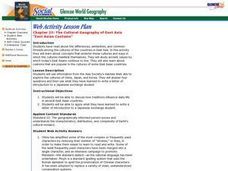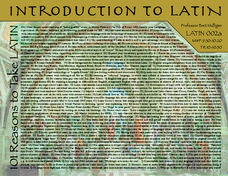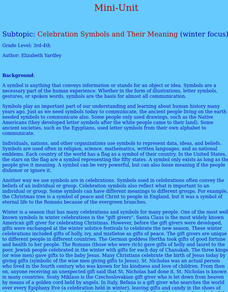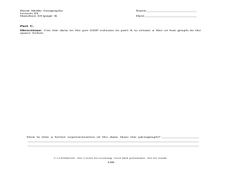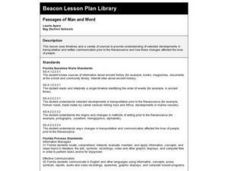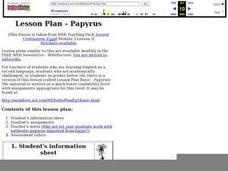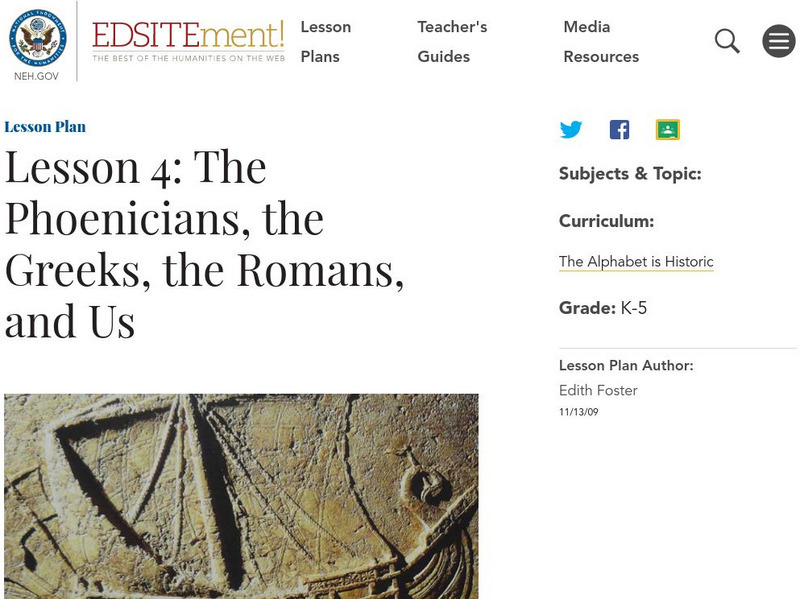Curated OER
The Alphabet is Historic: The Roman Alphabet is our Alphabet
Students show that the Greeks, Phoenicians and Romans lived in the Mediterranean area. They give reasons why the alphabet was important for the Romans. and say that the Romans developed the alphabet they are learning in school.
National Endowment for the Humanities
Lesson 4: The Phoenicians, the Greeks, the Romans, and Us
Learners review knowledge gained in the three-part unit on the history of the alphabet. Using maps and images, learners consolidate their understanding of ancient Greece, the Romans and the Phoenicians, and their respective impacts...
Curated OER
Familia Romana
Students compare and contrast ancient family life to present day family life. In this Roman family life lesson, students discuss the roles present in their families and then learn about family life in ancient Rome. Students...
Curated OER
The Alphabet is Historic
Young scholars describe how the Phoenicians, Greeks and Romans passed down the alphabet through the generations. They compare and contrast the letters from early alphabets to the one of today and discuss how they are different. Using a...
Curated OER
Alternative Alphabet
Learners determine and compare hieroglyph content and frequency to sentences constructed in an alternative alphabet based on symbols that mimic sounds of the alphabet. They decide which images are hieroglyphs and which ones are not.
Curated OER
Reading: Alphabet Uno Card Game
Students use the game of Uno to help them learn their numbers and colors. The cards have letters on them instead of numbers.
Curated OER
Scratch, Glue, Foil & Paint
Students sculpt large Greek and Roman letter design motifs, and replicate other examples of Greek and Roman artwork.
Curated OER
Religion in Japan Japanese Writing
Study the three writing systems of Japanese: Hiragana, Katakana and Kanji. Your middle schoolers will practice writing Kanji and write a mini story in English which uses at least 10 of the Kanji in the place of the English words....
Curated OER
Inuktitut
Learners explore Inuit language. In this Inuktitut lesson plan, students listen to a lecture about the history and phonology of the Inuit language. Learners create Inuktitut-English dictionaries with illustrations for...
Curated OER
China Rocks! Chinese Calligraphy on Stone
Students explore the art of calligraphy through writing Chinese characters. They view a Power Point as an introduction to Chinese calligraphy and practice writing Chinese characters. In groups, they visit centers to explore the history...
Curated OER
The Cultural Geography of East Asia
Students use information from the Asia Society's AskAsia Web site to explore the cultures of China, Japan, and Korea. They answer four questions and then use what they have learned to write a letter of introduction to a Japanese exchange...
Curated OER
Introduction To Latin
In this language arts worksheet, students examine the 101 reasons for taking a class in Latin. The syllabus has classical art for background on the cover page.
Curated OER
Celebration Symbols and Their Meaning
Learners develop a symbol that represents something they wish to celebrate or include in a celebration of their choosing.
Curated OER
Population and Population Density
Students read and interpret graphs. For this population lesson, students explore population and population density as they read several data graphs and respond to questions.
Curated OER
Passages of Man and Word
Third graders explore transportation and written communication prior to the Renaissance.
Curated OER
Papyrus
Students study what papyrus was and what it was used for. Students explore how papyrus was made, and the two writing systems hieroglyphics and cuneiform.
Curated OER
Look at What I Did at School!
Third graders use an outline to write a letter to their parents sharing their week at school.
Curated OER
More for Images and Lists
Learners design a hyper-linked graphic without a bounding border. They examine how to place a framing border around an inline image. They apply HTML to list using a number styles.
National Endowment for the Humanities
Neh: Edsit Ement: Lesson 3: The Roman Alphabet Is Our Alphabet
In this lesson plan, students will consider Lesson 3: The Roman Alphabet is our Alphabet. Worksheets and other supporting materials can be found under the Resources tab.
National Endowment for the Humanities
Neh: Edsit Ement: The Alphabet Is Historic
Great lesson plans for grades K-2 on the history of the alphabet. Includes guiding question, objectives, and four lessons with activities and assessments. With links to various websites containing information on alphabet history.
National Endowment for the Humanities
Neh: Edsit Ement: Lesson 4: The Phoenicians, the Greeks, the Romans, and Us
In this lesson plan, students will consider Lesson 4: The Phoenicians, the Greeks, the Romans, and Us. Worksheets and other supporting materials can be found under the Resources tab.

